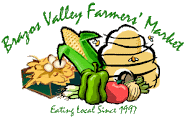History of the Brazos Valley Farmers' Market
by Patrick Gendron
After 17 years in the same location, the May 30, 2015, market will be the last in the Brazos County Health Department parking lot. Patrick Gendron, who served as market president many years, has kindly provided this retrospective. The new location will be north of Downtown Bryan between Main and Bryan Street, bordered on the North and south, respectively by 21st and 22 St.
by Patrick Gendron
In the early 1980’s, the Brazos Valley Farmers Market (under the coordination of County Agent Sistrunk) was located in the parking lot of the Brazos County Courthouse where the current Courthouse parking garage is located. In the mid to late 1980s the farmers market moved out to the parking lot of the County Extension Office on Highway 21 where it remained until the mid-90s. County Agent Dr. Jim Mazurkiewicz and later County Agent Jack Hunter acted as coordinators of the farmers market.
Around 1995 or so, for a few years the Bryan/College Station Realtors Association took over the leadership of the farmers market and moved it to the old Perry Brothers parking lot in Downtown Bryan at the northwest corner of William J. Bryan and Bryan Street where the current Discount Floors Superstore sits. For a year or two the farmers market went back to the parking lot of the County Extension Office on Highway 21.
In 1998, Patrick Gendron, Mark Burow, Josie Milberger, and Pete Lawson took over the leadership of the farmers market from the realtors. In 1999, it was decided to move the farmers market to its current location of 201 N. Texas Avenue at the corner of Texas Avenue and William J. Bryan Parkway (the parking lot of the Brazos County Health Department, which was once a Safeway Grocery Store) because it was a highly visible location and traffic count research showed it was one of the most traveled intersections in all of Brazos County.
Back then—as real estate agents would say—the most important aspect of advertising is really location, location, location. The main goal of the farmers market has always been to provide an avenue for farmers and gardeners to sell the fruits of their labor to fellow members of the community who have an appreciation for locally grown, fresh produce
Saturday
Friday
The Texas farm-to-market road
Although more a few Texas farm-to-market roads were transformed by population sprawl to urban beltways, such as the FM 1960 loop around Houston and FM 1604 loop around San Antonio, most FMs maintain their original country character. Farm-to-market and ranch-to-market roads account for more than 50 percent of Texas Highway System.
In 1937, the first farm-to-market road is completed between Mount Enterprise and Shiloh in Rusk County, in the East Texas pineywoods, a distance of 5.8 miles, but the beneficiary was the Temple Lumber Company sawmill. Soon after, though, urban area lobbyists pushed for gasoline taxes to be directed toward urban arterial routes. Prevailing over the urbanites was perceived need by Texans and their legislature to connect the isolated central and western part of the state. In 1949, the legislature amended Colson-Briscoe to earmark and additional $15 million of the state's annual General Revenue funding for farm-to-market and ranch roads to be matched with federal funds.
Ironically, when population growth turned farm-to-market and ranch-to-market roads into urban arterials, residents rejected as “un-Texas” the idea of renaming these roads Urban Roads. A few were renamed, and although they benefit from state maintenance, they do not receive federal funds for expansion.
In “Texas Primer: The Farm-to-Market Road” (Texas Highways, 1983), Paul Burka writes:” [The farm-to-market road ]is different from other highways: narrower, more winding, more attuned to the contours of the earth. You can’t drive as fast, and you don’t want to, because on a farm-to-market road, the feeling is of driving on the land, instead of past it.” Burka goes to say, “The farm-to-market road is to Texas what the freeway is to California: not just a highway, but a symbol of the culture.” <\
In 1937, the first farm-to-market road is completed between Mount Enterprise and Shiloh in Rusk County, in the East Texas pineywoods, a distance of 5.8 miles, but the beneficiary was the Temple Lumber Company sawmill. Soon after, though, urban area lobbyists pushed for gasoline taxes to be directed toward urban arterial routes. Prevailing over the urbanites was perceived need by Texans and their legislature to connect the isolated central and western part of the state. In 1949, the legislature amended Colson-Briscoe to earmark and additional $15 million of the state's annual General Revenue funding for farm-to-market and ranch roads to be matched with federal funds.
Ironically, when population growth turned farm-to-market and ranch-to-market roads into urban arterials, residents rejected as “un-Texas” the idea of renaming these roads Urban Roads. A few were renamed, and although they benefit from state maintenance, they do not receive federal funds for expansion.
In “Texas Primer: The Farm-to-Market Road” (Texas Highways, 1983), Paul Burka writes:” [The farm-to-market road ]is different from other highways: narrower, more winding, more attuned to the contours of the earth. You can’t drive as fast, and you don’t want to, because on a farm-to-market road, the feeling is of driving on the land, instead of past it.” Burka goes to say, “The farm-to-market road is to Texas what the freeway is to California: not just a highway, but a symbol of the culture.” <\
Subscribe to:
Posts (Atom)

